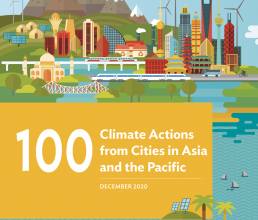First appeared in

Asian Development Bank
100 Climate Actions from Cities in Asia and the Pacific
City officials aim to improve connectivity and maximize the use of public transportation in the rapidly growing city of Gui’an, with the objective of achieving 60% public transport usage by 2030.
City officials aim to improve connectivity and maximize the use of public transportation in the rapidly growing city of Gui’an, with the objective of achieving 60% public transport usage by 2030.
Located in the landlocked province of Guizhou in southwestern PRC, the new city of Gui’an has a transportation system currently characterized by overcrowded road networks, high rates of traffic accidents, and low use of public transit.
60%
OF TOTAL TRIPS TAKEN WITH PUBLIC TRANSPORT
The Smart Transport System Development Project is scheduled to begin construction in 2021. As part of the plan, an intelligent transport system (ITS) will be developed to improve efficiency and facilitate multimodal public transportation through a range of real time data and management systems. This technology will be accompanied by the introduction of 200 battery-powered electric buses and a network of 21 electric charging stations. The project also will pilot autonomous vehicles and will eventually lend to mainstreaming such fleets in Gui’an’s transportation area. The use of this technology complements climate change actions by enabling fuel efficiency.
The provision of clean energy transportation options alongside improved connectivity is intended to make public transport a preferred mode of travel in Gui’an, consequently decreasing congestion, reducing pollution, and making the city more liveable.
The project will cost $495 million with funding coming from an ADB sovereign loan and government counterpart financing.

The project will create a flexible transport system that fits the needs of residents while also maximizing public transport use (photo by Pinky Serafica).
The Challenge
Accelerated urbanization has strained existing networks, which consist of only 10 bus routes, and public transport ridership is marginal at 10%.
Co-Benefits
Environment The provision of clean energy public transport modes such as electric buses can reduce emissions by 30-40%, reducing environmental pollution in the city.
Social The project will increase environmental awareness among youth through coding camps and hackathons related to green mobility and ITS technology.
Economic The ITS will enable people and freight to move more easily, which can subsequently attract private sector investment and boost the local economy.

